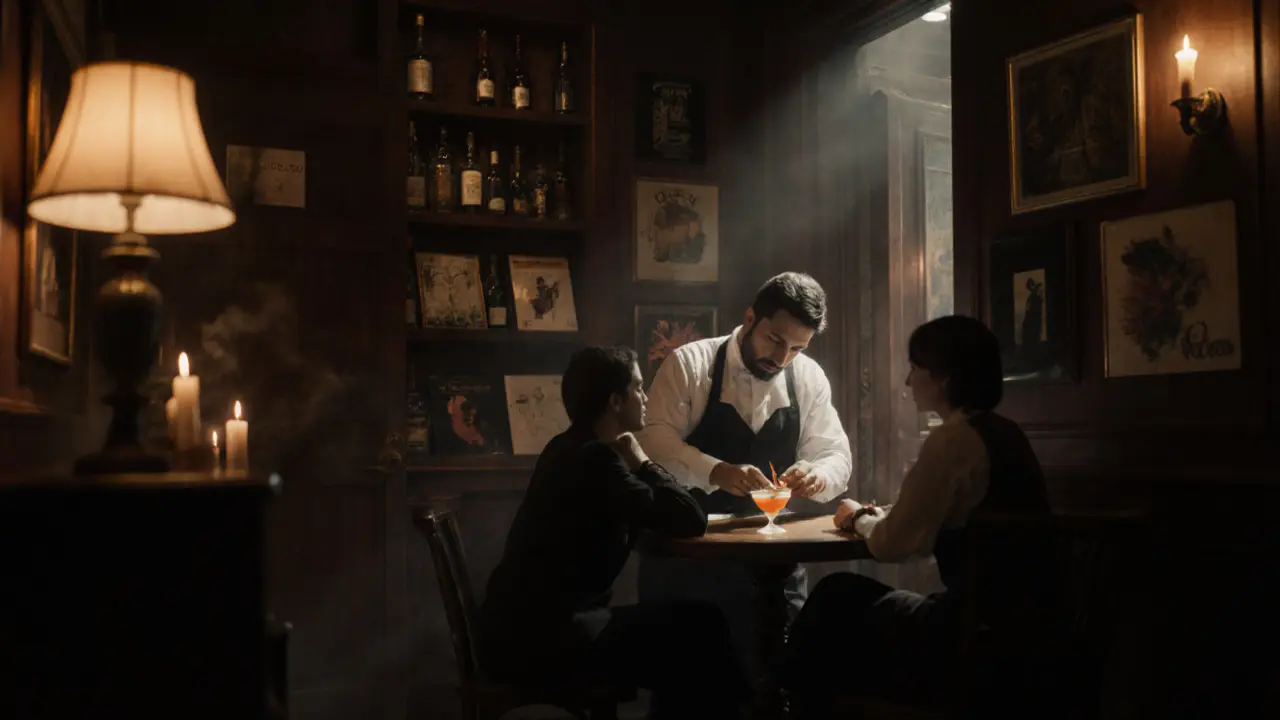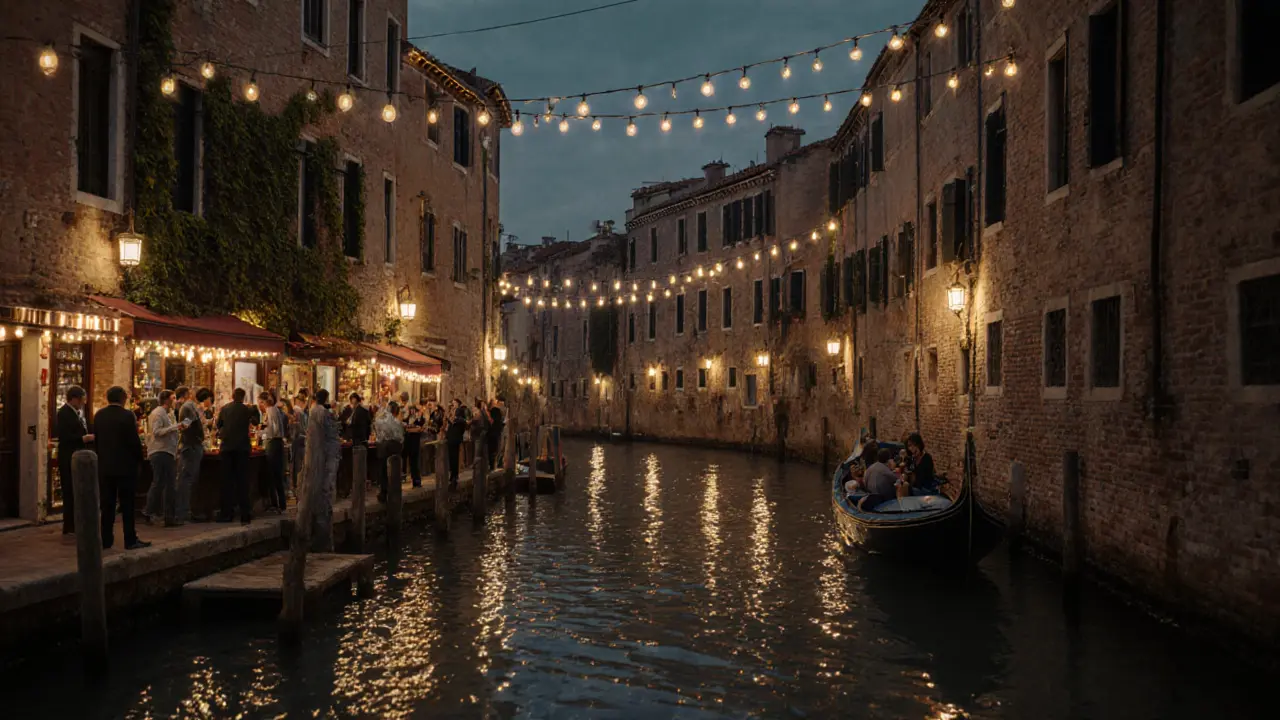When the sun sets over Milan, the city doesn’t sleep-it switches gears. By 10 p.m., the quiet elegance of Brera gives way to pulsing basslines in Navigli, and the sleek lobbies of five-star hotels spill out into candlelit cocktail lounges. This isn’t just partying. It’s a ritual. A carefully curated dance between fashion, art, and after-dark energy that’s been refined over decades. If you think Milan is all about runway shows and designer boutiques, you’re missing half the story. The real magic happens when the lights dim and the city turns up.
Where the Night Starts: Navigli District
Start your night in Navigli. This is where Milanese locals go when they want to unwind without the tourist crowds. The canals, lined with old warehouse buildings now turned into bars and restaurants, glow with string lights and the soft hum of conversation. Don’t miss La Bitta, a tiny spot known for its natural wines and tiny plates of cured meats. It’s standing room only, but worth the squeeze. Around 11 p.m., the crowd thins just enough to make room for the next wave-people moving from drink to drink, not to get drunk, but to stay in the rhythm.
Walk a few blocks to Bar Basso, the birthplace of the Americano. Order one. It’s bitter, sweet, and exactly what you need before heading to the clubs. The bar has been here since 1915. It doesn’t need neon signs or DJs. Its reputation is built on consistency, history, and the fact that every Milanese bartender knows how to pour it right.
Clubbing Like a Local: The South Side
If you’re looking for clubs, skip the flashy names on tourist blogs. The real scene is tucked away in the south, near Porta Genova. Magazzini Generali is a converted warehouse with industrial ceilings and a sound system that shakes your ribs. They don’t play Top 40. They play deep house, techno, and experimental beats from underground Italian and European DJs. Doors open at midnight. By 2 a.m., it’s packed. No dress code, but no flip-flops either. You’ll see suits next to leather jackets. That’s Milan.
Just down the street, Officine Grandi Riparazioni (OGR) hosts bigger names-international DJs, live electronic acts, and art installations that turn the night into an experience. It’s not cheap, but it’s not overpriced either. A drink here costs €12, not €25. And you’re not just paying for alcohol-you’re paying for the space, the vibe, the art. This isn’t a club. It’s a cultural event.
The Hidden Gems: Rooftops and Speakeasies
Not everyone wants to dance. Some want to watch the city sparkle from above. Head to Terrazza Aperol on the top floor of the Galleria Vittorio Emanuele II. It’s not a secret, but it’s still quiet enough to talk. The view of the Duomo at night is worth the €15 cocktail. Order the Aperol Spritz. It’s the unofficial drink of Milan, and no one here will judge you for it.
For something quieter, find Bar del Fico in the Brera neighborhood. It’s hidden behind a fake bookshelf. No sign. Just a buzzer. You need a reservation. Inside, it’s dim, cozy, and full of poets, artists, and old-school jazz lovers. The bartender knows your name by the second round. They don’t have a menu. They ask what mood you’re in. Then they make you something you didn’t know you needed.

What to Wear (And What Not To)
Milan doesn’t care if you’re rich. It cares if you care. You don’t need Gucci to get in. But you do need to look like you put thought into it. No sneakers. No hoodies. No baseball caps. Jeans? Fine. But make sure they’re clean, tailored, and not ripped. A simple blazer over a T-shirt works better than a full suit. Women wear dresses, but not the kind you’d wear to a wedding. Think silk, minimal jewelry, and heels you can walk in.
Locals notice. Not to judge, but to fit in. You’re not here to stand out. You’re here to blend into the rhythm. If you look like you’re trying too hard, you’ll stick out. If you look like you belong, you’ll get the best table, the best seat, the best vibe.
When to Go and How Long to Stay
Milan doesn’t follow the same clock as other cities. Dinner starts at 9 p.m. Bars fill up at 11. Clubs hit their stride at 1 a.m. and don’t slow down until 5 a.m. Most people don’t even think about going home until sunrise. If you’re used to calling it a night at midnight, you’ll be left behind.
Plan for a long night. Start early. Sip slowly. Move between places. Don’t try to cram everything into one spot. The point isn’t to check off clubs. It’s to feel the city breathe. One bar. One club. One rooftop. That’s enough if you’re present.

What’s New in 2025
This year, a few new spots opened that are already becoming legends. La Cucina di Nonna is a retro 70s-style bar hidden under a trattoria in Porta Venezia. It serves cocktails named after Italian films and plays vinyl records from the same era. No Wi-Fi. No phones allowed after 10 p.m. It’s the anti-social media bar-and it’s packed every weekend.
Then there’s Le Serrande, a floating bar on the Adda River just outside the city center. Accessible by private boat or a 20-minute train ride, it’s become the weekend escape for Milan’s creatives. Open only on Fridays and Saturdays, it’s got live acoustic sets, fire pits, and no cover charge. You pay for drinks, not entry. And you leave with your clothes smelling like woodsmoke and river mist.
How to Get Around After Dark
The metro runs until 1:30 a.m. on weekdays and 2:30 a.m. on weekends. After that, you’ll need a taxi or ride-share. Uber is reliable, but it’s expensive. Local apps like FreeNow or ItTaxi are cheaper and faster. Don’t try to walk long distances after midnight. Some neighborhoods are safe, but others aren’t worth the risk.
Pro tip: If you’re staying near the Duomo, walk to Navigli. It’s only 20 minutes, and the streets are well-lit. But don’t wander into the industrial zones near Lambrate unless you know the area.
Why Milan’s Nightlife Is Different
It’s not about the music. It’s not even about the drinks. It’s about the people. Milanese nightlife is quiet, intentional, and deeply personal. You won’t find screaming crowds or over-the-top themed nights. You’ll find conversations that last hours. Eyes that lock across a table. A shared silence that says more than any song ever could.
This is a city that knows how to live. Not just party. Not just drink. But to be present. To savor. To move with the night, not against it. That’s why people come back. Not because it’s the wildest. But because it’s the most real.
Is Milan nightlife safe for tourists?
Yes, Milan’s nightlife is generally safe for tourists, especially in popular areas like Navigli, Brera, and Porta Genova. Stick to well-lit streets, avoid isolated alleys after 2 a.m., and use licensed taxis or ride-share apps. Pickpocketing is rare but possible in crowded bars, so keep your bag zipped and your phone secure.
What’s the best night to go out in Milan?
Friday and Saturday nights are the busiest, but Wednesday and Thursday are when locals go out without the tourist crowds. If you want to experience the real scene, go midweek. Clubs are less packed, drinks are cheaper, and the energy feels more authentic.
Do I need to make reservations for bars and clubs in Milan?
For popular spots like Bar del Fico, Le Serrande, or OGR on big event nights, yes-book ahead. Most casual bars and smaller clubs don’t require reservations, but arriving before 11 p.m. guarantees you a seat. Waitlists can be long after midnight.
Are there any age restrictions for clubs in Milan?
Most clubs require you to be at least 18, but some upscale venues set the limit at 21. Always carry ID, even if you look older. Bouncers check rigorously, especially on weekends. Underage guests are not allowed, even with adult supervision.
Can I pay with credit cards everywhere?
Most bars and clubs accept cards, but smaller venues, especially in Navigli, still prefer cash. Carry at least €30-50 in euros. ATMs are plentiful, but avoid using them inside bars-pick one on the street instead.
What’s the average cost of a night out in Milan?
A casual night out-two drinks at a bar, one cocktail at a rooftop, and a club entry-costs about €50-70. If you’re hitting high-end venues like OGR or Le Serrande, budget €100-150. Food isn’t included, but many bars serve small plates for €8-15.
If you’re looking for something deeper than a party, Milan’s night is waiting. Not loud. Not flashy. Just real. And once you’ve felt it, you’ll understand why people return year after year-not for the clubs, but for the quiet moments between the beats.

